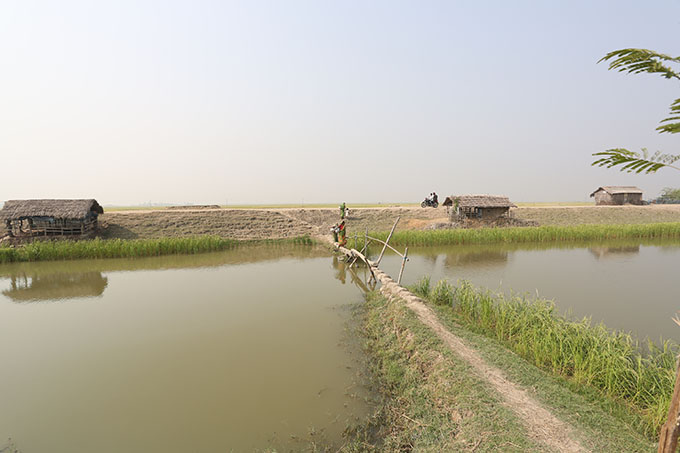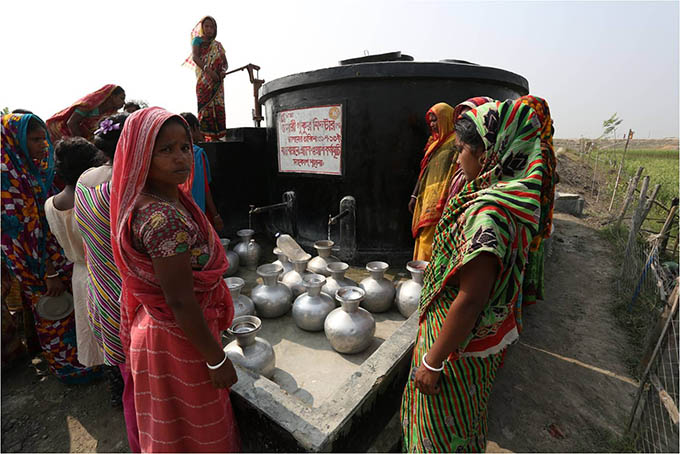Reading Time: 2 minutes
Sutarkhali is located in Khulna, next to the mangrove forests of Sundarbans. Climate change in this southern region has seen cyclones with more damaging effects. The sea level is rising, and loss of land through erosion and saltwater intrusion makes it hard to find safe drinking water. There are 40 million people living in the coastal belt of Bangladesh who rely on natural water sources to sustain their livelihoods and daily needs.
Sutarkhali is located in Khulna, next to the mangrove forests of Sundarbans. Climate change in this southern region has seen cyclones with more damaging effects. The sea level is rising, and loss of land through erosion and saltwater intrusion makes it hard to find safe drinking water. There are 40 million people living in the coastal belt of Bangladesh who rely on natural water sources to sustain their livelihoods and daily needs.
This year, people in Sutarkhali were able to harvest rice paddy for the first time since the cyclone Aila hit Bangladesh in 2009. The sweet water ponds in these areas flooded with salt water after the cyclone. The community depends on the river Sibsa, but its water stays sweet for six months after monsoons, and the salt concentration changing to high levels during the other six months. The small number of ponds remains as the major source of water. Deep tube wells are often not a good option in this region, as saltwater intrudes into the aquifer system due to the reduction of upstream freshwater flow.
High salinity levels in water may have several negative impacts on health, contributing to kidney stones and rheumatism, and pre-eclampsia and gestational hypertension for pregnant women. Such situations demand close observations followed by appropriate actions.
To date, BRAC’s water, sanitation and hygiene programme (WASH) has created additional access to safe drinking water for 2.3 million people across the country. Despite its success, salinity intrusion in hard-to-reach areas remains a challenge. The project, SWIBANGLA: Managing salt water intrusion impacts in coastal groundwater systems of Bangladesh addresses the problem of saltwater intrusion. It monitors salt levels in groundwater, issues early warnings and reduces abstraction when salinity levels increase. It has also proposed potential mitigation measures such as injecting fresh water into deep aquifers, to be stored and pumped up for use when required.
Pond sand filters are an effective and low-cost option for areas such as Sutarkhali where high salinity is a problem. In 2013, BRAC WASH constructed a pond sand filter in Gunari village of Sutarkhali, with the capacity to serve 50-60 families. These filters require regular maintenance and cleaning, all of which involve money and labour. Previous government-initiated pond sand filters in the region were unfortunately, found to be dysfunctional. In BRAC’s programme areas, a water management committee oversees each pond sand filter, encouraging participation from the community to help keep the filters functioning.
A large share of the population still remain underserved and have to resort to consuming water with high salt concentrations (the mean water sodium level is 554 mg/l in Sutarkhali). Recently, an innovative pilot project has been initiated in Tala, one of the coastal sub-districts, where water options are evaluated in each area by trialling different technologies like deep tube wells, pond sand filters, rain water harvesting, and water quality testing of existing water sources. Low-cost and appropriate interventions best suited to each individual area are identified. Based on learnings, the appropriate interventions will be scaled up in other coastal areas where access to drinking water is limited.
Bangladesh has successfully met the MDG target of safe drinking water. Today, 85 per cent of the population has access to safe water. However, the task of reaching out to the rest remains, many of who reside in salinity-affected areas. BRAC WASH continues to take lessons and work for innovative and sustainable solutions to address the challenges existing in the coastal belts of Bangladesh.
Sabrina Shahidullah is a senior communications specialist for BRAC’s water, sanitation and hygiene programme.







